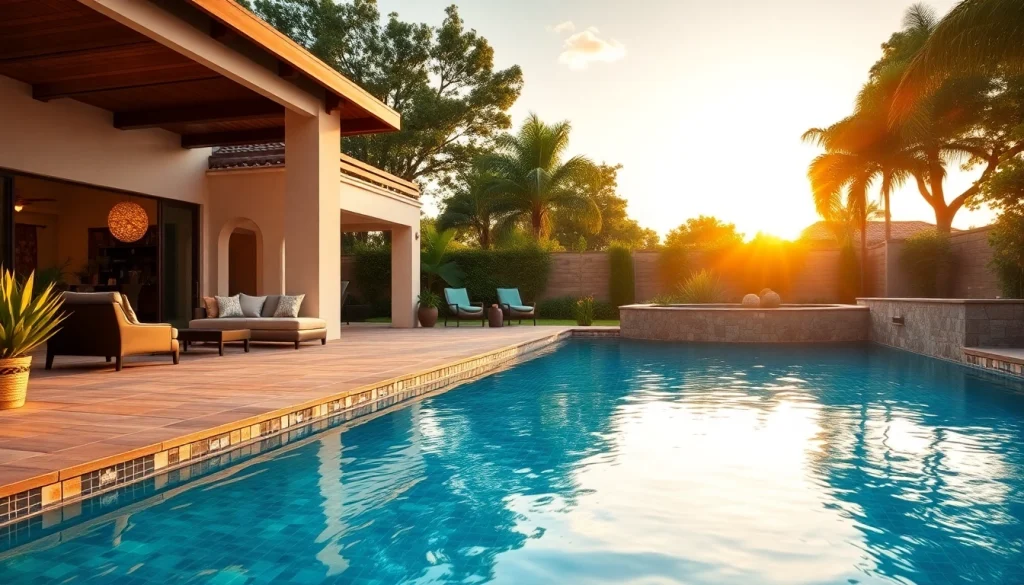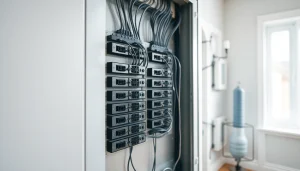
Understanding the Basics of a Pool Remodel
Embarking on a pool remodel requires a thorough understanding of what the process entails. Whether you wish to transform an aging pool into a modern oasis or you simply want to reinvigorate your backyard space, knowledge is key in navigating this substantial investment. In this section, we will explore the definitions, motivations, and key terminology associated with pool remodeling.
What is a Pool Remodel?
A pool remodel refers to the comprehensive process of upgrading or renovating an existing swimming pool. This can range from simple cosmetic enhancements, such as new tiles or a fresh layer of plaster, to extensive modifications including changes in shape, depth, or layout. The goal is often to improve the aesthetics, functionality, and safety of the pool area while increasing its value in the process. Remodeling can also encompass additions like spas, integrated lighting systems, or eco-friendly features that enhance the overall pool experience.
Key Reasons for Considering a Pool Remodel
There are numerous reasons homeowners decide to embark on a pool remodel, including:
- Increased Home Value: A well-executed pool remodel can significantly enhance the market value of a home, making it more appealing to potential buyers.
- Modernization: Updating dated designs and features ensures the pool aligns with current trends and technologies, enhancing both functionality and aesthetic appeal.
- Safety Concerns: Remodeling can address safety issues by installing features like non-slip surfaces, improved fencing, or automatic pool covers.
- Personal Preference: A remodel allows homeowners to customize the pool to fit their lifestyle needs, whether that includes adding a shallow play area for children or incorporating features for entertainment.
Common Pool Remodeling Terminologies
To navigate the complexities of a pool remodel, it’s essential to be familiar with some key terms:
- Plaster: The interior finishing material of the pool, typically a mix of plaster and aggregate.
- Coping: The cap or edge of the pool that transitions from the pool to the surrounding deck.
- Decking: The area around the pool that provides a surface for activities and lounging.
- Resurfacing: The process of renewing the pool’s surface by applying a new layer of plaster, pebble, or other materials.
- Tile Work: The installation of decorative tiles on the waterline or throughout the pool’s surface for aesthetics and maintenance benefits.
Cost Analysis: What to Expect from Your Pool Remodel
Understanding the cost dimensions associated with a pool remodel is crucial, as it allows homeowners to effectively plan their budget and set realistic expectations. This section will break down average costs, factors influencing expenses, and offer budgeting tips to navigate the remodeling journey.
Average Cost Breakdown for a Pool Remodel
The costs associated with remodeling a pool can vary widely depending on several factors such as location, size, type of renovation, and materials used. On average, a pool remodel can cost anywhere from $10,000 to $25,000, with more extensive projects reaching upwards of $50,000. Here’s a general breakdown:
- Minor Cosmetic Repairs: $1,500 – $5,000 (includes resurfacing and minor tile work)
- Moderate Remodel: $5,000 – $15,000 (includes new coping, waterfall features, and landscaping)
- Major Renovation: $15,000 – $50,000+ (includes structural changes, completely new surface, or features like spas and slides)
Factors Influencing Pool Remodel Costs
Several key factors can influence the total cost of a pool remodel. Understanding these can help homeowners anticipate expenses better:
- Size of the Pool: Larger pools require more materials and labor, increasing costs.
- Location: Local labor costs can vary significantly; urban areas typically charge more than rural locations.
- Type of Materials: Premium materials, such as glass tiles or high-end finishes, can drive costs higher.
- Extent of Remodel: A cosmetic update will be more budget-friendly than a complete overhaul.
- Contractor Fees: Hiring skilled professionals can be more expensive but may lead to better-quality outcomes.
Budgeting Tips for Your Pool Remodeling Project
Effective budgeting is a vital step in any pool remodel. Here are practical tips to keep your costs in check:
- Set a Realistic Budget: Factor in all aspects, including materials, labor, and future maintenance costs.
- Prioritize Expenses: Identify what’s non-negotiable versus nice-to-have and allocate funds accordingly.
- Get Multiple Quotes: Work with several contractors to compare prices and services offered.
- Consider DIY Options: If you have the skills, handling small tasks yourself can save on labor costs.
- Plan for Contingencies: Set aside an additional 10-20% of your budget to cover unforeseen expenses that may arise during the remodel.
Popular Design Trends in Pool Remodeling
The design landscape for pools is ever-evolving, reflecting changing tastes, advances in technology, and a growing consciousness around eco-friendliness. In this section, we’ll delve into some of the latest trends in pool remodeling design.
Incorporating Eco-Friendly Features
Today’s homeowners are increasingly interested in sustainable living, leading many to consider eco-friendly features in their pool remodels:
- Energy-Efficient Equipment: Upgrading to energy-efficient pumps, heaters, and lighting can drastically reduce energy consumption and costs.
- Natural Filtration Systems: Using biofilters or natural plants creates a chemical-free ecosystem, improving water quality.
- Solar Heating Systems: These systems capture sunlight to heat pool water, making it accessible all year round without relying on traditional heating methods.
Modern Aesthetics: Tiling and Surface Options
Modern pools often feature sophisticated designs, with textures and colors that create a visually stunning impact. Consider these options:
- Glass Tiles: An elegant choice that adds depth and shimmer to the pool surface.
- Pebble Finishes: A natural stone finish provides a rustic look while reducing the risk of slipping due to its textured surface.
- Custom Mosaics: Personalized mosaic designs can be incorporated into the pool bottom or walls, offering a unique artistic flair.
Creative Landscaping Ideas Surrounding Your Pool
Enhancing the pool area with thoughtful landscaping can create a tranquil retreat:
- Native Plants: Using plants that thrive in your local environment not only reduces maintenance but can also improve biodiversity.
- Decking Materials: Combating slippery surfaces is essential; consider adding wooden or composite materials that blend aesthetics with safety.
- Integrated Seating: Incorporating built-in seating areas around the pool creates a cohesive and inviting atmosphere.
Steps to Effectively Plan Your Pool Remodel
A successful pool remodel requires detailed planning. By following a structured approach, homeowners can ensure their project runs smoothly and meets their expectations.
Assessing Your Current Pool Condition
Before diving into a remodel, it’s critical to assess your current pool’s state:
- Inspect for Damage: Identify cracks, leaks, or fading surfaces that may require immediate attention.
- Evaluate Features: Consider the effectiveness of existing features and whether they align with your current lifestyle and aesthetics.
- Budget Review: Assess existing funding allocations for repairs and upgrades.
Finding and Hiring the Right Contractor
The success of your remodel is heavily dependent on your choice of contractor. Here are some tips to find the right one:
- Research Credentials: Look for licensed contractors with good standing in your community and check reviews and references.
- Get Bids: Obtain estimates from multiple contractors to compare costs, timelines, and services.
- Clarify Expectations: Clearly communicate your vision and budget constraints to align expectations effectively.
- Assess Communication: Choose a contractor who communicates openly and maintains transparency throughout the process.
Permitting and Compliance Considerations
Many areas require certain permits for pool renovations:
- Check Local Regulations: Be aware of local zoning laws, safety regulations, and environmental standards that may impact your project.
- Permitting Process: Understand the steps needed to obtain necessary permits and the duration it may take.
- Consult with Professionals: Engaging an architect can help ensure designs meet all requirements, saving you time and potential fines.
Maintaining Your Newly Remodeled Pool
Once your pool remodel project is complete, maintaining it will be key to preserving its look and functionality over time. This section offers essential tips for caring for your newly upgraded pool.
Essential Maintenance Tips Post-Remodel
Regular upkeep can prolong the life of your pool and its surfaces:
- Regular Cleaning: Skim the surface, vacuum, and brush the walls regularly to prevent algae buildup.
- Water Balance: Test and balance the water chemistry frequently to ensure safe swimming conditions.
- Inspect Equipment: Routinely check pumps, filters, and heating systems for signs of wear and tear.
Seasonal Care for Your Pool
Seasonal changes may require specific considerations:
- Winterizing: In colder climates, properly winterize your pool to prevent damage during freezing temperatures.
- Summer Readiness: Before swimming season, ensure proper cleaning, chemical treatment, and that features like heating are functional.
Long-term Upgrades to Consider for Future Remodels
Even after a remodel, consider planning future upgrades to keep your pool modern and functional:
- Smart Technology: Adding smart home features can enhance monitoring and operation, providing convenience and efficiency.
- Additional Features: Consider introducing a hot tub, swim-up bar, or water features such as waterfalls to enhance the experience.
- Energy-Efficient Solutions: Investing in energy-efficient technologies can reduce costs and environmental impact long-term.






